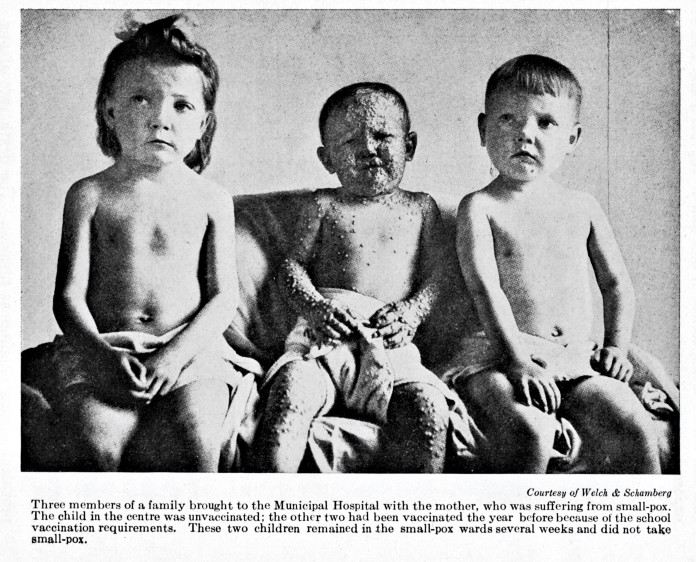Vaccines save lives. The history of disease, epidemics, and public health clearly demonstrates this. And yet, there has always been a very vocal opposition to vaccines, an opposition that continues to rage in very public forums. More public education about the benefits and potential risks of vaccines – which are typically quite minimal as vaccines are a highly tested and regulated product – is needed to enable people to make educated, considered choices about whether they vaccinate themselves and their children.
The exhibit, Vaccines & Immunization: Epidemics, Prevention and Canadian Innovation, which opened at the Museum of Health Care in November and will remain as a semi-permanent exhibit for the next several years, attempts to do just this.
Developed with Guest Curator Dr. Christopher Rutty, and funded in part by the Kingston and United Way Community Fund, the Coalition of Canadian Healthcare Museums and Archives, and Sanofi Pasteur, the exhibit uses case studies of diseases that saw significant decreases in the twentieth century because of immunization – smallpox, diphtheria, polio, and whooping cough – to identify the cost of epidemics to society and explore the search for adequate treatment and preventative measures, such as vaccines.
By discussing the impact of epidemics on individuals and society in the short- and long-term, and showing how drastically vaccines affected incidence and mortality rates, the exhibit strives to make people think not only of the risks (perceived or real) of vaccines but also why they were celebrated discoveries.
Let us look more closely at the case of polio, which is a focal point of the exhibit.
Polio presents initially much like the flu. Throughout much of history, most people were exposed to polio in their youth creating adult immunity; however, by the early twentieth century improvements in hygiene meant that more and more adults had never been exposed to polio and were vulnerable to the disease. Many people are able to fight off the disease with only minor symptoms, but in others the viral infection affects the nerves causing muscle weakness and paralysis. In the most life-threatening cases, paralysis affects the tongue, throat muscles and diaphragm, leaving the patient at great risk of suffocation.
How was the disease treated in the past? For some, paralysis was temporary and with rehabilitation therapy full mobility could be restored. Others required braces, canes, or wheelchairs for the rest of their lives. Similarly, for those who suffered through bulbar polio – affecting the respiratory system – the primary treatment was an iron lung.
Iron lungs use negative pressure to inflate and deflate the lungs of the patient inside, helping them to get oxygen. The patient’s body is placed inside the iron lung while the head and neck protrude onto a canvas stretcher at one end. When the motor is running, pressure will alternatively build up inside the machine, causing the lungs to become smaller, and then decrease inside the machine, causing the lungs to expand and fill with air.
Since cases of polio seemed to increase in the warmer months, fear and anxiety settled over many communities in the summer and early fall. Parents would keep their children close to home and forbid activities, such as swimming in the local pool, that were associated with contracting of polio.
The polio virus was first isolated in 1908, but the search for a polio vaccine made great strides in the 1940s and 1950s thanks to innovations by a number of researchers. Connaught Laboratories made critical contributions when its scientists discovered a synthetic medium in which to grow the virus and a way to effectively grow large amounts of virus by rocking the cultures. This enabled enough vaccine to be produced to conduct field trials of an inactivated polio vaccine developed by Dr. Jonas Salk in 1954. North America waited on tenterhooks to hear the results, broadcasted on 12 April 1955. The vaccine was successful at protecting against polio! It should not be underestimated how exciting this news was. From a peak rate of 60 cases per 100,000 in the early 1950s, incidence dropped to nearly zero by 1962.
With a vaccine for polio only discovered in 1954, many Canadians can still recall the fear of polio and remember friends and family members who were stricken with the disease; yet, younger generations have little personal connection to the disease and less understanding about what its consequences can be.
Without being educated about the dangers of polio – which is still endemic in several countries – and other infectious and contagious diseases it is possible that the much publicized “risks” of vaccines will have no counter-balance. It is important to provide balanced, well supported evidence to people so that they can make informed decisions. We hope that this exhibit will contribute to critical reflection and much needed discussions around the family dinner table.




